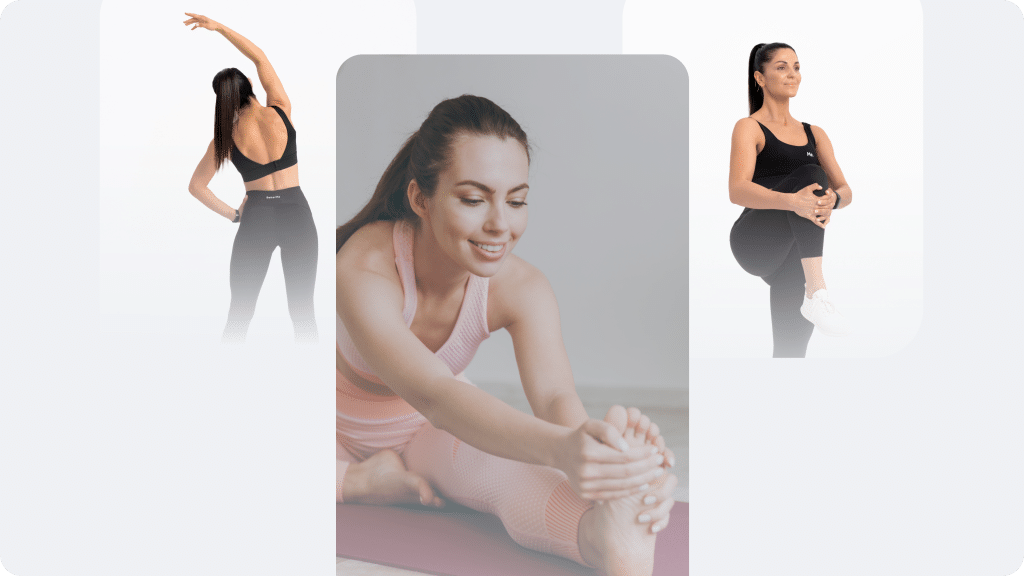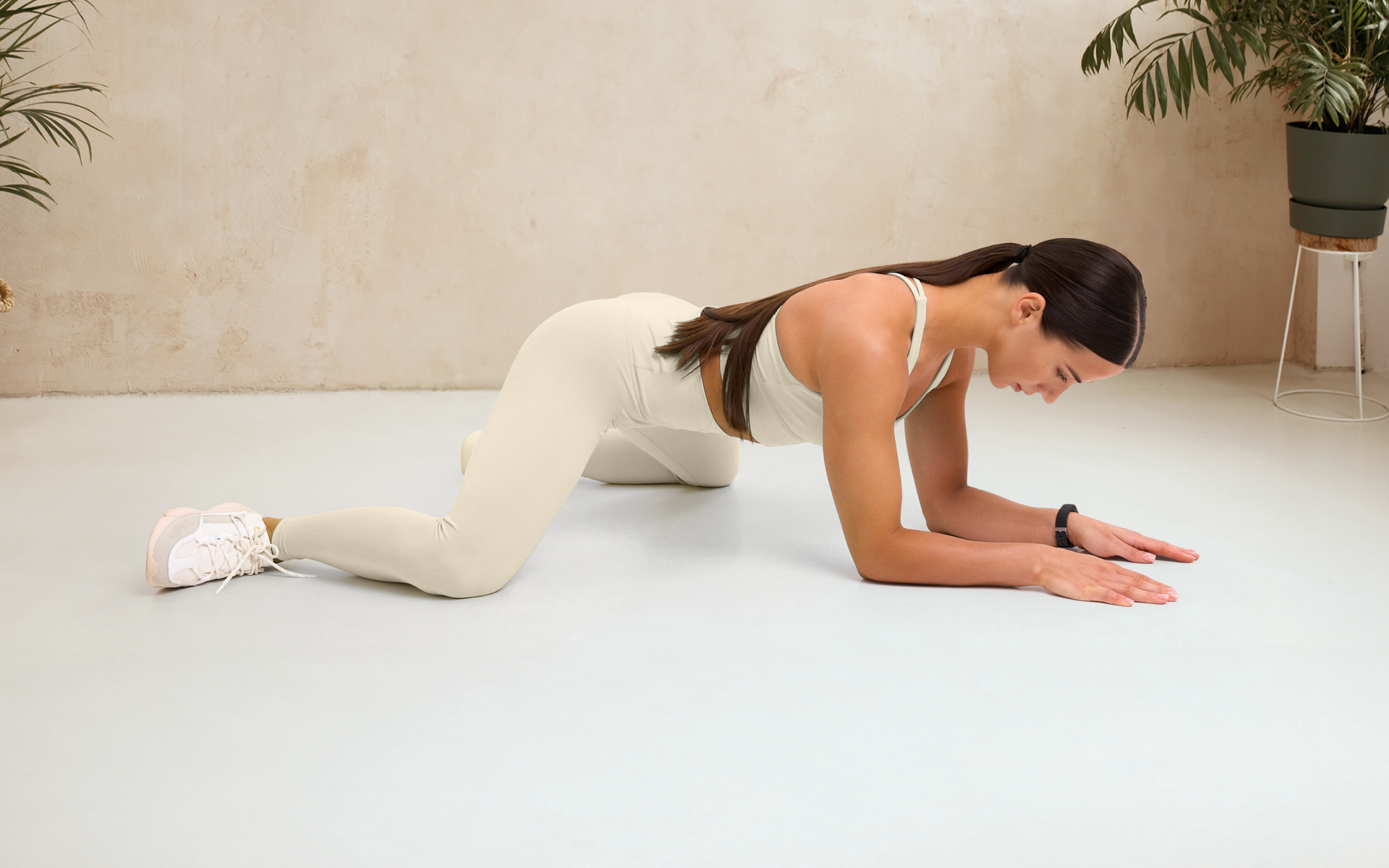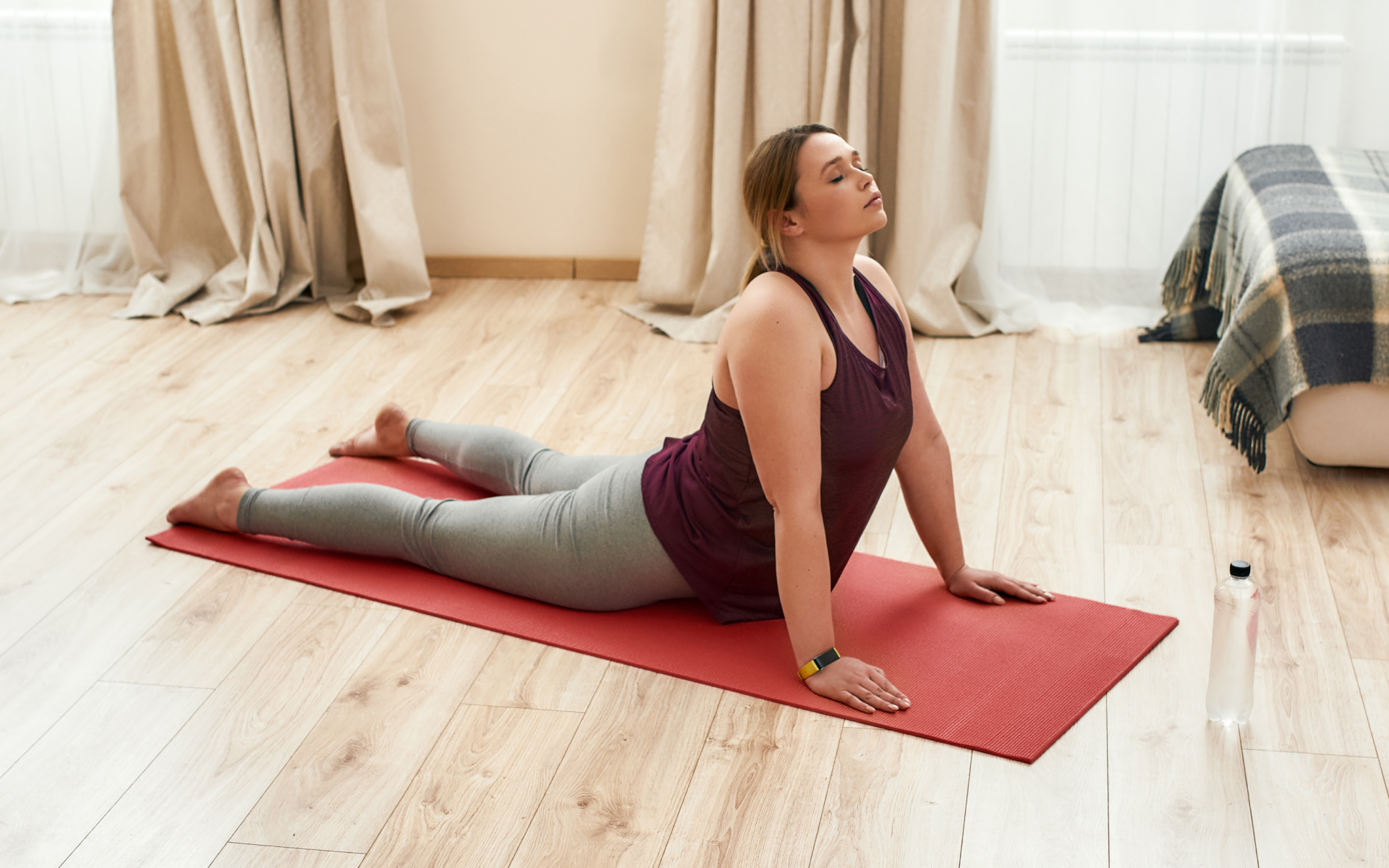Somatic exercises have been gaining popularity as a holistic, simple, and effective way for women to deepen their mind-body connection. Women often live busy lives of multi-tasking and juggling many things, whether it’s a full-time job, managing a home, taking care of kids, or all of the above.
Women often deal with a lot of stress. Stress gets trapped in the body when unresolved emotions and tension accumulate in the muscles and nervous system, manifesting as physical discomfort, pain, or chronic health issues. And truthfully, many women struggle to de-stress their lives, and instead of relieving it, they push it aside.
In addition, with the craziness of life, sometimes we women forget to prioritize our mental well-being. Pushing aside stress can lead to bigger issues, but somatic exercises can help women relieve stress and focus on the connection between mind and body, improving their mental well-being.
As the interest in somatic exercise grows, so does the curiosity: what exactly is a somatic workout, and how does it benefit women specifically? In this blog, we will look at somatic exercises for women, how to do them, and what benefits they have for women of all ages.
What Is the Truth About Somatic Workouts for Women?
Truthfully, somatic exercises for women can be an incredible way to relieve stress and improve mental focus. These exercises are gentle, mindful movements that focus on increasing body awareness, releasing tension, and improving the mind-body connection. These exercises help individuals tune into their internal sensations, allowing them to process emotions and alleviate stress stored in the body (1).
Let’s talk about mental health. Women deal with a lot of stress on top of dealing with the frustrations, emotions, discomfort, and pains of menstruation. Women typically have difficulty finding time to de-stress and focus on themselves (2).
However, somatic exercises are a great avenue for women to focus on their wellness and connect with their bodies in a way that doesn’t take a lot of time and can easily fit into their daily lives, no matter how busy they are. A full somatic workout takes approximately 20–40 minutes to complete, but if you’re pressed for time, you can do a quick 5–10-minute somatic workout that’s also effective.
Somatic exercises are a way for women to improve their mind-body connection and develop a deeper awareness of their bodily sensations. The more you know your body and its sensations and movements, the better you’ll be able to read what your body needs. For example, you may be able to better determine where and why your body is stressed and then perform somatic exercises focusing on those areas, ultimately relieving tension and stress, which may improve your sleep.
Read more: Types of Somatic Therapy: How Different Practices Promote Healing
Is Somatic Exercise Evidence-Based?
While more conclusive evidence and studies on the effectiveness of somatic exercises are needed, some smaller studies have yielded conclusive results that these exercises do have many benefits.
The findings of a small research study published in 2017 suggest that somatic experiencing can help people address and release the negative emotional effects and symptoms of trauma even if the trauma has been present for years (3). It’s important to note here that somatic exercises involve mindful movements to enhance body awareness and release tension, while somatic experiencing is a trauma-focused therapy that uses guided awareness of bodily sensations to process and release stored trauma.
Another small study in 2013 found evidence that somatic techniques can help reduce fatigue and chronic back pain. In addition, these somatic techniques also help promote bodily and emotional awareness and improve your mood and emotional mindset (4).
According to a 2017 study, a somatic approach can also reduce unwanted emotions and promote a more positive emotional experience by changing your body language (5).
As you can see, despite the need for larger studies, there are smaller studies that show that incorporating somatic exercises into your daily or weekly workout routine truly has benefits that can significantly impact your life.
BetterMe will keep you laser-focused on your weight loss journey! Nutrient-packed meal plans, fat-blasting workouts, galvanizing challenges and much more. Try using the app and see for yourself!
What Is an Example of a Somatic Workout for Women?
There are many somatic exercises that women can do, but we’re going to look at ones that specifically help relieve stress and trauma and help with emotional wellness, weight loss, and targeting belly fat.
Somatic Exercises for Weight Loss
Somatic exercises are usually low-intensity, but they can still be used as a tool for weight loss. Somatic exercises can also help with weight loss by improving sleep, reducing stress, and keeping your cortisol levels under control, which helps prevent emotional overeating that leads to weight gain (6).
Walking is a type of somatic movement that helps you become more aware of your body and mind while you walk, as somatic walking involves focusing on your inner experience. This means focusing on what your body is feeling as you move, rather than walking for the purpose of burning calories.
Another type of somatic exercise for weight loss is somatic dancing. This focuses on the body’s movements, sensations, and feelings. This somatic movement helps you get in touch with your internal self and emotions and can help you explore and engage your emotional, physical, and cognitive processes through movements and dance (7). Somatic dance isn’t choreographed. Instead, it encourages intuitive, freestyle movement. This type of somatic exercise is great for getting your body moving and may help reduce stress and worry, both of which can help with weight management and weight loss when properly managed.
Somatic Exercises to Release Trauma
Sometimes it’s easy for women to push their emotions aside without dealing with them. This can lead to built-up trauma that stores itself in the body, resulting in physical symptoms including headaches, sleep issues, chronic pain, worry, muscle tightness, and more (8). Using somatic therapy exercises can help the body process trauma by focusing on its sensations and emotions.
Grounding exercises are a type of somatic therapy exercise that helps release trauma from the body by creating a sense of stability and anchoring you in the present moment through the awareness of sensations around you. One effective grounding exercise involves running cold water over your hands. As the water flows over your skin, focus on the cool, tingling sensation, the temperature change, and the feeling of water moving across each finger, allowing these sensations to bring you back to the here and now (9).
Another popular grounding technique is the 5-4-3-2-1 exercise, where you consciously identify five things you can see, four things you can touch, three things you can hear, two things you can smell, and one thing you can taste. These exercises help calm the nervous system, promote relaxation, and reduce stress by fully engaging your senses and reconnecting with your body (10).
Somatic therapy exercises also include somatic experiencing (SE), an approach to healing trauma by addressing the body’s stress response and nervous system regulation. This approach recognizes that trauma doesn’t just impact the mind, it can also become trapped in the body, triggering automatic stress responses such as fight, flight, or freeze. Somatic experiencing helps release this trauma by focusing on these responses and guiding the individual to tune into their body’s sensations, gradually releasing stored tension and restoring a sense of safety and balance. (11).
Read more: Somatic Exercises for Cortisol Belly
What Are the Criticisms of Somatic Experiencing?
While somatic experiencing may sound like an amazing tool for releasing trauma, it has faced some criticism that often comes with holistic approaches.
A common criticism of somatic experiencing is that it lacks evidence-based research. However, there is some ongoing research that can verify and prove its validity and effectiveness in releasing trauma and promoting emotional well-being (11).
Somatic Exercises for Belly Fat
Belly fat is often caused by high cortisol levels. At high stress levels, the body releases and overproduces cortisol, which causes fat to be stored in the abdominal area (12). Somatic movements can help reduce belly fat by reducing cortisol and stress levels, which helps with weight management (13).
Somatic exercises can help you relieve stress and tension, connect with your body, and regulate your nervous system. Progressive muscle relaxation (PMR) is an effective, easy exercise you can do to help reduce stress and relax the tension in your muscles (14). The purpose of this exercise is to identify areas of tension and stress in the body.
Here’s a step-by-step guide to how to perform progressive muscle relaxation:
- Get comfortable. Sit or lie down in a quiet area in a position that’s comfortable for you.
- Focus on your breathing. Breathe deeply through your nose, hold for a few seconds, and then exhale slowly through your mouth, concentrating on breathing in while you tense your muscles and exhale as you release them.
- Tense up. Start at the top of your body and tense up your head and face. Hold the tension for five seconds, and then exhale to release the tense muscles in your face and head.
- Tense your upper body. When you’ve released the tension in your head, move on to the shoulders, upper back, and chest. Once again, hold your breath and tense for five seconds before releasing.
- Continue downwards. Continue tensing and releasing your muscles, working your way down from your head, arms, torso, legs, and feet, holding each tensing and inhaling for five seconds.
- Finish strong. To end, simply tense your whole body at once, hold for five seconds, and then completely relax and release all of your muscles while exhaling. Repeat this process several times until you feel very relaxed (15).
Somatic Exercises for Women over 40
Somatic exercises can be helpful for menopausal women as they can alleviate the irritating symptoms that accompany this transition. Menopause symptoms often include brain fog, hot flashes, night sweats that result in poor sleep, and mood swings. So you may be wondering, how can somatic exercises help menopause symptoms?
Incorporating somatic exercises into your daily or weekly routine can alleviate menopause and perimenopause symptoms by reducing stress and helping you focus more on the present. Somatic exercises also regulate the nervous system, which could be beneficial for menopausal women. (16). Practicing gentle, relaxing somatic exercises can help you get in touch with your emotions and reduce stress, which results in a better night’s sleep—combating the sleep issues that often accompany menopause.
One of the best somatic exercises for women who are dealing with menopausal hot flashes is somatic yoga. Hot flashes can be reduced through yoga by incorporating cooling breath techniques and movements that calm the mind and reduce stress. (17).
Somatic Exercises for Plus-Size Women
A great somatic exercise for plus-size women is the breath awareness exercise. This exercise can help steady your breathing, making you feel calmer and less worried. This exercise is a great starting point for beginners and a good prelude to another somatic exercise. By focusing on your breathing and sensations, the breath awareness exercise can calm your mind.
To start the breath awareness exercise, begin by sitting or lying down in a relaxed state. Close your eyes and feel where your body moves as you breathe in and out. Focus on the feelings and sensations in your nostrils, throat, chest, lungs, and abdominal area. Note the way your body moves—your hips and back—as you breathe in and out (18).
The somatic breath awareness exercise is a great way to bring awareness to your breath, reduce stress, and support emotional healing (19). Try this beneficial somatic exercise to try to help relax your body and relieve stress!
BetterMe will shake off your mental funk, rid you of your energy-zapping habits, and help you sculpt the body of your dreams. Intrigued? Hurry up and change your life for the better!
How Do I Start Somatic Exercise?
Here’s the thing about somatic exercises: they’re easy for almost anyone to do, no matter their age, fitness level, or location. You can do somatic exercises in the comfort of your home with no equipment—some exercises can even be done from the comfort of your bed!
An easy place to start with somatic exercise is somatic stretches. By using gentle movements and paying attention to the way your muscles feel in different positions and motions, somatic stretching can release muscle tension (20).
One easy somatic stretch is the standing awareness exercise. This helps you bring awareness to your body. To do this exercise, start by standing straight with your feet firmly rooted on the ground, paying special attention to how they grip the floor. Now contract and release the muscles in your feet. Breathe deeply, noticing how your abdominal muscles expand and contract. As you scan your body from top to bottom, notice how each muscle feels and identify any areas of tension.
If you’re feeling overwhelmed by the thought of where to start with somatic exercises, don’t worry. There are plenty of amazing resources out there that help guarantee you have the information and tools you need to create an amazing somatic workout plan. Download the BetterMe app for access to invaluable resources, guides, information, and even health coaches to help get you started on your somatic exercise journey.
What Is a Somatic Workout Plan for Women?
Women may benefit from a somatic workout plan that focuses on reducing stress and improving sleep. In addition, for women dealing with menopause, incorporating somatic yoga to help alleviate hot flashes could be beneficial. While regular yoga focuses on achieving specific poses and physical fitness, somatic yoga is designed to emphasize internal sensations and mindful awareness of movement to deepen the mind-body connection and release tension.
We’ve already looked at several helpful exercises for women to combat stress and poor sleep, release trauma, and reduce menopause symptoms.
To recap these exercises, an effective somatic workout plan for women may include a routine of:
- Somatic Dancing: To get your body moving and help you get in touch with your emotions and feelings.
- Grounding: This simple exercise can help release trauma from the body and help you focus on the present.
- Progressive Muscle Relaxation: This helps you identify areas of tension in your body so you can focus on addressing and releasing them. In addition, releasing stress also helps improve sleep.
- Somatic Yoga: Menopausal yoga can help reduce hot flashes for women over 40.
- Breath Awareness Exercise: This helps you focus on your breathing, reduce stress, and help with emotional healing.
- Standing Awareness Exercise: This is a simple exercise that helps bring awareness to your body and helps develop a strong mind-body connection.
Yes, Pilates can be a somatic workout when it’s practiced with full awareness of both mind and body (21). Yes, yoga is a somatic exercise when it’s practiced by focusing on your movement and noting the sensations in your body, rather than focusing on getting your body into a specific pose (22). Somatic experiencing is a holistic approach to releasing trauma that is stored in the body. This technique focuses on releasing the emotions and tension associated with trauma in your body (11). Somatic exercises often focus on releasing emotions and, sometimes, trauma. As somatic exercises release emotions and stress and relax your body, this can often lead to a feeling of deep relaxation and even feeling tired (23).Frequently Asked Questions
Is Pilates a somatic workout?
Is yoga a somatic workout?
Do somatic exercises release trauma?
Is it normal to feel tired after somatic exercise?
Summary
As you can see, somatic exercise provides many benefits for women’s holistic well-being. Incorporating somatic workouts into your daily routine can help relieve stress in an easy way and only requires a short amount of time out of your busy life. These exercises also enhance the mind-body connection, which serves to improve mental focus and clarity. In addition, somatic exercise can improve sleep and emotional well-being, release trauma, and help with menopause symptoms.
These somatic workouts typically range from 10 to 40 minutes and include exercises such as somatic walking, dancing, breath awareness, grounding, and progressive muscle relaxation, all of which aim to enhance emotional wellness, manage stress, and potentially help with weight loss by regulating cortisol levels.
Overall, somatic workouts are an amazing approach to fitness and emotional well-being that specifically target women’s needs, whether you’re aiming to relieve stress, manage your menopause symptoms, or support your emotional healing.
DISCLAIMER:
This article is intended for general informational purposes only and does not serve to address individual circumstances. It is not a substitute for professional advice or help and should not be relied on for making any kind of decision-making. Any action taken as a direct or indirect result of the information in this article is entirely at your own risk and is your sole responsibility.
BetterMe, its content staff, and its medical advisors accept no responsibility for inaccuracies, errors, misstatements, inconsistencies, or omissions and specifically disclaim any liability, loss or risk, personal, professional or otherwise, which may be incurred as a consequence, directly or indirectly, of the use and/or application of any content.
You should always seek the advice of your physician or other qualified health provider with any questions you may have regarding a medical condition or your specific situation. Never disregard professional medical advice or delay seeking it because of BetterMe content. If you suspect or think you may have a medical emergency, call your doctor.
SOURCES:
- Movement-Based Therapies in Rehabilitation (2020, Physical Medicine and Rehabilitation Clinics of North America)
- Women and Stress (2019, clevelandclinic.org)
- Somatic Experiencing for Posttraumatic Stress Disorder: A Randomized Controlled Outcome Study (2017, ncbi.nlm.nih.gov)
- Better or Worse: a Study of Day-to-Day Changes over Five Months of Rosen Method Bodywork Treatment for Chronic Low Back Pain (2013, pubmed.ncbi.nlm.nih.gov)
- A Somatic Movement Approach to Fostering Emotional Resiliency through Laban Movement Analysis (2017, ncbi.nlm.nih.gov)
- Somatic Exercises For Weight Loss: Do They Work? (2024, myjuniper.com)
- Somatics Studies and Dance ((iadms.org)
- How Does Your Body Remember Trauma? Plus 5 Ways to Heal (2023, psychcentral.com)
- 11 Somatic Grounding Exercises For When You Need To Manage Your Triggers (2023, betterme.world)
- Exploring mindfulness and the 5-4-3-2-1 grounding activity (2022, lpft.nhs.uk)
- Somatic experiencing – effectiveness and key factors of a body-oriented trauma therapy: a scoping literature review (2021, ncbi.nlm.nih.gov)
- Stress-induced cortisol response and fat distribution in women (1994, ncbi.nlm.nih.gov)
- Mindfulness Intervention for Stress Eating to Reduce Cortisol and Abdominal Fat among Overweight and Obese Women (2011, ncbi.nlm.nih.gov)
- Progressive Muscle Relaxation (va.gov)
- Somatic Techniques for Stress and Anxiety (brooklynsomatictherapy.com)
- 4 Somatic Practices to Help Regulate Your Nervous System in Flight Response (elevatetherapywellness.com)
- Yoga for menopausal symptoms—A systematic review and meta-analysis (2018, maturitas.org)
- 8 Somatic Breathing Exercises to do today(originalbodywisdom.com)
- How Somatic Breathwork Can Help You Chill Out (2023, charliehealth.com)
- Somatic Stretching: How It Works, Benefits, and Starter Exercises (2024, everydayhealth.com)
- Pilates and Somatic Movement Education and Therapy (thepilatesstudioinhadley.com)
- Yoga and Somatics (ekhartyoga.com)
- Explore Somatic Therapy FAQs with Natalia Rachel (nataliarachel.com)












